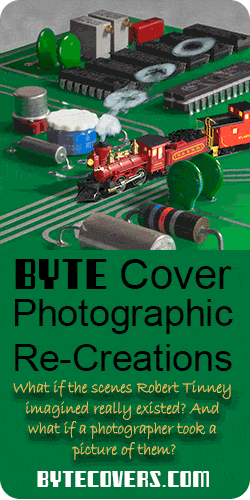 Many people are turning old hard disks into clocks. They disassemble old disk drives and put a clock mechanism behind the mirrored disc platter. They’re using 3½” disks, so they end up with itty bitty little clocks. I wanted something big enough to hang on the wall and retro enough to satisfy my nostalgia for the computers of my youth.
Many people are turning old hard disks into clocks. They disassemble old disk drives and put a clock mechanism behind the mirrored disc platter. They’re using 3½” disks, so they end up with itty bitty little clocks. I wanted something big enough to hang on the wall and retro enough to satisfy my nostalgia for the computers of my youth.

In the 1960s and 70s, mainframes and minicomputers used removable disk packs. Each pack was a stack of several 14” disks. I had the joy of using these disks on a Honeywell 200 computer at my first job.
I bought two old 14” disks via the Internet. I wanted the clock’s numerals to echo the vintage computing theme, so I rendered them in the old Magnetic Ink Character Recognition (MICR) font, which was widely recognized as “computer numbers” in the 1970s and which can still be found on checks today. I sent the rendering off to Ponoko to have them laser cut out of black acrylic.

One of the disks had a metal hub in the center, the other didn’t. For the disk with the metal hub, I needed to drill a 5/16” hole to mount the clock mechanism. For the disk without a hub, I needed something to fill the empty space and to hold the clock mechanism. On eBay, I bought a vintage printed circuit board for a Digital Equipment Corp. PDP-11 (an asynchronous multiplexer board, for those who care), drilled a hole for the clock mechanism’s shaft, and glued the disk to it.
The end result is two beautiful clocks worthy of an aging geek with a mid-life crisis. Which do you think looks better? Vote for one or the other below!


[poll id=”2″]

Are the platters shiny? Shiny is best.
They’re reflective.
How about using the arms that carried the read-write heads, or replicas thereof, as hands? I’ve just used an H200 disk platter to stand a water butt on in the garden. Perhaps a matching sundial would be an idea, the head assembly arm being the gnomon.
That would be a good idea, if only I could get those hands.
was that whole stack only 200MB?
My wife recently got a new cell phone. She put in a 4GB SD card and asked me “so what is this, just a little bit of flash memory?”
She had to listen to me rant about how 4GB “is not a little bit!!” and my first floppy disk was 80K and my first hard disk was 5MB and my first computer was 16K etc. etc. etc.
PRESS PLAY ON TAPE
Ahh, the glory days.. 🙂
Yes, “only” 200MB, in an era of 800/1600 bits per inch tape (typical 9-track reel-to-reel tape was ~50MB according to sources on the ‘net) and 256kB of RAM.
[Yes, that’s kB with a 1024. Often mis-typed as KiB, for those who don’t realize addressing is in powers of 2]
Kids these days .. 🙂
They are indeed gorgeous, nice build!
The first one is easier to fit in a general location than the second which calls for nostalgia, also the plated one is easier to remove dust, but it seems colder than the one with circuits. I voted for the second one (score is 40% – 60%).
BTW, you can use the dip switch to set the alarm.
And to keep them used as they are used to you may rotate the disks to show the time (use 2 for a clock).
Sweet project. I think the one with the metal hub LOOKS best, but the one with the circuit board takes it for coolness.
I once knew a junk dealer with a semi-working PDP-11. I sure wish I had that monster now…
How do I buy one?
What size did you do your Numbers that you sent to Ponoko?
The digits ended up being 3.7 cm tall. I forget what point size I used.